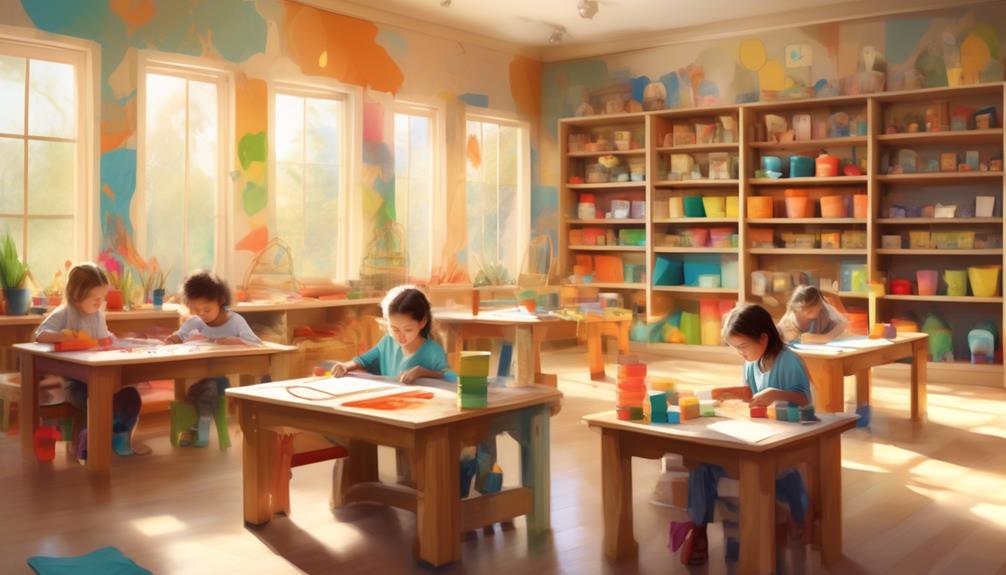What Is the Montessori Method and Is It Right for Your Child?

The Montessori method is an educational approach developed by Dr. Maria Montessori. It focuses on fostering independence, self-motivation, and a love for learning in children.
Discover the key principles, benefits, and considerations of the Montessori method to determine if it's the right fit for your child.
History of the Montessori Method
The Montessori Method has a rich history that dates back to the early 1900s when it was developed by Dr. Maria Montessori as a revolutionary approach to education. The method has evolved over time, adapting to the changing needs of students and the educational landscape. Dr. Montessori's initial focus was on children with special needs, but she soon realized the impact her method could have on all children.
The Montessori Method emphasizes the importance of allowing children to learn at their own pace and pursue their individual interests. It encourages hands-on learning and provides a prepared environment that promotes exploration and independence. This approach has been proven to foster critical thinking, problem-solving skills, and a love for learning.
Over the years, the Montessori Method has gained recognition and popularity worldwide. It has been embraced by parents, educators, and researchers who recognize its effectiveness in nurturing children's development and academic success. Many renowned individuals, including Larry Page and Sergey Brin, the founders of Google, credit their Montessori education for their innovative thinking and success.
The impact of the Montessori Method can be seen in the way it has influenced modern education. Its principles have been integrated into various educational philosophies and programs, demonstrating its enduring relevance. Today, Montessori schools can be found in countries around the globe, providing children with a unique and enriching educational experience.
Key Principles of the Montessori Method
Immerse your child in a learning environment that promotes independence, exploration, and hands-on learning with the Montessori Method.
The key principles of this educational approach revolve around the concepts of age and prepared environment, as well as child-centered learning.
One of the fundamental aspects of the Montessori Method is recognizing that children have different developmental needs at different ages. The curriculum is designed to cater to these needs, offering activities and materials that are suitable for each stage of a child's development. This ensures that they're challenged and supported at the right level, fostering a love for learning.
Another important principle is the concept of the prepared environment. Montessori classrooms are carefully arranged to provide a range of learning opportunities. Everything is organized and accessible, allowing children to choose their activities and work at their own pace. This not only promotes independence but also encourages exploration and discovery.
Child-centered learning is at the core of the Montessori Method. Teachers act as guides, observing and understanding each child's unique interests and abilities. They provide individualized instruction and support, allowing children to follow their passions and develop at their own rhythm. This approach fosters a sense of ownership and responsibility for their learning.
Benefits of the Montessori Method
As you explore the Montessori Method further, you'll discover the numerous benefits it offers for your child's learning and development. One of the key advantages of this approach is its child-centered nature. Unlike traditional education systems where the teacher leads the instruction, the Montessori Method puts your child at the center of their own learning journey. This empowers them to take ownership of their education and develop a sense of independence and self-motivation.
Another significant benefit is the emphasis on hands-on learning. In a Montessori classroom, your child will have the opportunity to engage with materials and activities that are specially designed to stimulate their senses and promote active exploration. Through this interactive approach, they can develop important skills such as problem-solving, critical thinking, and creativity.
To give you a clearer picture, here is a table summarizing some of the key benefits of the Montessori Method:
| Benefits of the Montessori Method |
|---|
| Child-centered approach |
| Hands-on learning |
| Development of independence |
| Cultivation of self-motivation |
| Fostering of critical thinking |
Montessori Education Vs. Traditional Education
When comparing Montessori Education to Traditional Education, you'll find distinct differences in their approaches to teaching and learning. Traditional teaching methods often involve a teacher-centered approach, with the teacher being the sole authority figure in the classroom. The teacher imparts knowledge to the students through lectures and textbooks, and students are expected to passively absorb the information. On the other hand, Montessori education emphasizes a child-centered approach, where the teacher acts as a guide to facilitate the child's learning.
One of the advantages of Montessori education is its focus on individualized learning. In a Montessori classroom, children are encouraged to learn at their own pace and follow their own interests. They've the freedom to choose their activities and work on them for as long as they need. This promotes a love for learning and allows children to develop their strengths and interests.
Furthermore, Montessori education promotes hands-on, experiential learning. Children are given the opportunity to learn through exploration and discovery. They've access to a wide range of materials and are encouraged to use their senses to explore and understand concepts. This approach fosters critical thinking, problem-solving skills, and creativity in children.
In contrast, traditional education often relies on rote memorization and standardized testing. This can limit the development of critical thinking and problem-solving skills.
Is the Montessori Method Suitable for All Children?
So, you're considering the Montessori Method for your child, but you're wondering if it's suitable for all children? Well, there are a few important factors to consider.
Firstly, age and developmental readiness play a crucial role in determining if a child will thrive in a Montessori environment.
Additionally, each child has their own unique learning style, and the Montessori Method may not align with every child's preferences.
Lastly, if your child has special educational needs, it's important to evaluate if the Montessori approach can effectively address those needs.
Age and Developmental Readiness
The Montessori Method offers a unique educational approach that takes into consideration a child's age and developmental readiness. It recognizes that children develop at their own pace and have individual learning styles. In a Montessori classroom, the curriculum is designed to meet the needs of each child based on their specific stage of development.
This means that children aren't forced to learn concepts that they aren't yet ready for, but instead are given the freedom to explore and learn at their own pace. The Montessori Method believes in providing a prepared environment that's rich in materials and activities that are appropriate for each age group.
Individual Learning Styles
As each child develops at their own pace and possesses unique learning styles, the Montessori Method caters to individual needs and ensures a suitable educational experience for all children. In a Montessori classroom, children are encouraged to explore and learn at their own pace, following their natural learning preferences. The Montessori approach recognizes that children have different strengths and weaknesses, and provides personalized instruction to meet their specific needs.
To accommodate individual learning styles, Montessori classrooms offer a variety of materials and activities that cater to different learning preferences. Whether a child is a visual learner, auditory learner, or kinesthetic learner, they will find opportunities to engage with the curriculum in a way that best suits their learning style. This personalized approach allows children to feel empowered and motivated in their learning journey.
Below is an example of how the Montessori Method caters to individual learning styles:
| Learning Style | Montessori Approach |
|---|---|
| Visual Learners | Use of visual aids, such as charts and diagrams, to enhance understanding. |
| Auditory Learners | Opportunities for discussions and presentations to promote active listening. |
| Kinesthetic Learners | Hands-on activities and manipulatives to encourage tactile learning. |
| Multimodal Learners | Integration of various learning styles to create a well-rounded educational experience. |
Special Educational Needs
Is the Montessori Method suitable for children with special educational needs? The answer is yes.
Montessori education promotes inclusivity and can be adapted to meet the needs of students with diverse learning abilities. The Montessori approach emphasizes individualized learning and allows children to progress at their own pace. This flexibility makes it conducive for students who may require additional support or have specific learning challenges.
Montessori classrooms are designed to be inclusive, providing a prepared environment that caters to the unique needs of each child. Teachers in Montessori schools receive training on how to adapt the materials and activities to accommodate special needs students.
Montessori Method in Practice: Classroom Environment
Step into a Montessori classroom and you'll notice a carefully designed layout that encourages independent learning.
The classroom environment is intentionally set up to foster exploration and discovery, with various learning stations and materials readily accessible to children.
This allows them to choose their own activities and work at their own pace, promoting self-motivation and a love for learning.
Classroom Layout and Design
In the Montessori classroom, the layout and design are carefully crafted to foster a dynamic and engaging learning environment for your child. The classroom organization is intentionally designed to promote independence and self-directed learning. Learning spaces are divided into different areas, each catering to specific activities and developmental needs.
Imagine walking into the Montessori classroom and seeing a carefully arranged layout that encourages exploration and discovery. On one side, you'll find a practical life area, equipped with child-sized tools and materials for activities like pouring, scooping, and buttoning.
In the center, there's a section dedicated to sensorial activities, where your child can explore and refine their senses through activities like sorting and grading objects by size, shape, and color.
And in another corner, you'll find a language and math area, filled with materials that encourage literacy and numeracy skills development.
This intentional classroom design allows your child to move freely, choose their activities, and engage in meaningful learning experiences at their own pace.
Independent Learning Opportunities
Experience the Montessori classroom environment that empowers your child to take charge of their own learning journey. In a Montessori classroom, independent learning opportunities are abundant, allowing your child to develop their unique learning style while following the Montessori curriculum. Here are three ways your child can embrace independent learning:
- Self-selected activities: Your child has the freedom to choose activities that spark their interest, fostering a love for learning and allowing them to explore their passions.
- Self-paced learning: In the Montessori classroom, your child sets their own pace, giving them the opportunity to delve deeper into subjects they find fascinating and move ahead when they're ready.
- Teacher as a guide: The Montessori teacher acts as a guide, observing and supporting your child's learning journey, helping them navigate challenges and discover their strengths.
With these independent learning styles, your child will develop a lifelong love for learning and become an active participant in their education.
Montessori Materials and Curriculum
When exploring the Montessori Method for your child, you will discover a rich array of carefully designed materials and a thoughtfully crafted curriculum that fosters independent learning and holistic development. Montessori materials are specifically designed to engage children's senses and promote hands-on learning. These materials are carefully selected to match the child's developmental stage and provide opportunities for exploration, problem-solving, and creativity.
In a Montessori classroom, you will find a wide variety of materials that cover different subjects such as language, math, science, and practical life skills. The curriculum is designed to be flexible and adaptable, allowing children to progress at their own pace and follow their individual interests. This approach encourages a love for learning and helps children develop a deep understanding of the concepts they are exploring.
To give you a better idea of the types of materials you might find in a Montessori classroom, here is a table that showcases a few examples:
| Subject | Montessori Materials |
|---|---|
| Language | Sandpaper letters, movable alphabet |
| Math | Number rods, golden beads |
| Science | Botany puzzles, animal classification cards |
| Practical Life Skills | Pouring activities, dressing frames |
As you can see, the Montessori Method provides a wide range of materials that are carefully designed to support your child's learning and development. By incorporating these materials into the curriculum, Montessori education creates an enriching and engaging environment that nurtures your child's natural curiosity and love for learning.
How to Decide if the Montessori Method Is Right for Your Child
Deciding if the Montessori Method is the right educational approach for your child requires careful consideration of their unique learning needs and goals. Here are some key factors to help you make an informed decision:
- Age-appropriate: Consider your child's age and developmental stage. The Montessori Method is designed to cater to each child's individual pace of learning. It provides a structured yet flexible environment that allows children to progress at their own pace, promoting a sense of independence and self-motivation.
- Learning environment: Montessori classrooms are carefully prepared to facilitate hands-on learning experiences. They're filled with age-appropriate materials that encourage exploration and discovery. The classrooms are typically mixed-age, allowing children to learn from and with their peers. This fosters a sense of community and collaboration.
- Philosophy alignment: The Montessori Method emphasizes the holistic development of the child, focusing not just on academics but also on social, emotional, and practical life skills. Consider if this aligns with your own educational philosophy and goals for your child.
Ultimately, choosing the right educational approach for your child is a personal decision. Visit local Montessori schools, talk to teachers, and observe the classrooms to see if the Montessori Method resonates with your child's unique learning style and needs.
Frequently Asked Questions
What Is the History of the Montessori Method?
The Montessori Method's history is an intriguing tale of evolution and influences. It has transformed education, empowering children to explore, create, and learn at their own pace. Discover the fascinating journey that shaped this innovative approach.
What Are the Key Principles of the Montessori Method?
The key principles of the Montessori method focus on promoting independence, self-directed learning, and individualized instruction. Through a hands-on approach and a carefully designed implementation process, children are encouraged to explore, discover, and develop at their own pace.
What Are the Benefits of the Montessori Method?
The Montessori Method offers numerous benefits and advantages for your child. It promotes independence, creativity, and critical thinking skills. By allowing them to learn at their own pace, they can develop a love for learning that will last a lifetime.
How Does Montessori Education Compare to Traditional Education?
In the modern world, the Montessori approach stands out from traditional education. It emphasizes independence, hands-on learning, and individualized instruction. It's a refreshing alternative for your child's educational journey.
Is the Montessori Method Suitable for All Children?
The Montessori method is a child-centered approach that emphasizes individualized learning. It may not be suitable for all children, as each child has unique needs and learning styles.










